Attachment B1 - All Child Feeding Practices Handouts ENGLISH
Attachment B1 - All Child Feeding Practices Handouts ENGLISH - 2012 12 12.docx
Generic Clearance to Conduct Formative Research
Attachment B1 - All Child Feeding Practices Handouts ENGLISH
OMB: 0584-0524
Site: ______________________________ OMB Control #0584-0524
Date: _____________________________ Expiration Date: 04/30/2013
OMB
BURDEN STATEMENT:
According to the Paperwork Reduction Act of 1995, no persons
are required to respond to a collection of information unless it
displays a valid OMB control number. The valid OMB control
number for this information collection is 0584-0524. The time to
complete this information collection is estimated as 105 minutes,
including the time for reviewing instructions and completing the
information.
Attachment B1: Message Handout – All Child Feeding Practices Messages and Supporting Content
CF1.
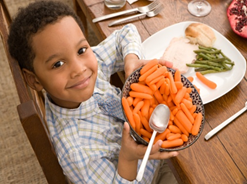
Let
them learn by feeding themselves.
Let your kids serve themselves at dinner. Teach them to make small amounts at first. Tell them they can get you more if they’re still hungry.
CF2.

Sometimes
new foods take time.
Kids
don’t always take to new foods right away. Offer new fruits and
vegetables many times, served a variety of ways. Give your kids just
a taste at first and be patient with them.
C F3.
F3.
Patience
works better than pressure.
Offer
your children new foods. Then, let them choose how much to eat. Kids
are more likely to enjoy new foods when eating them is their own
choice. It also teaches them how to be independent.
CF1a.
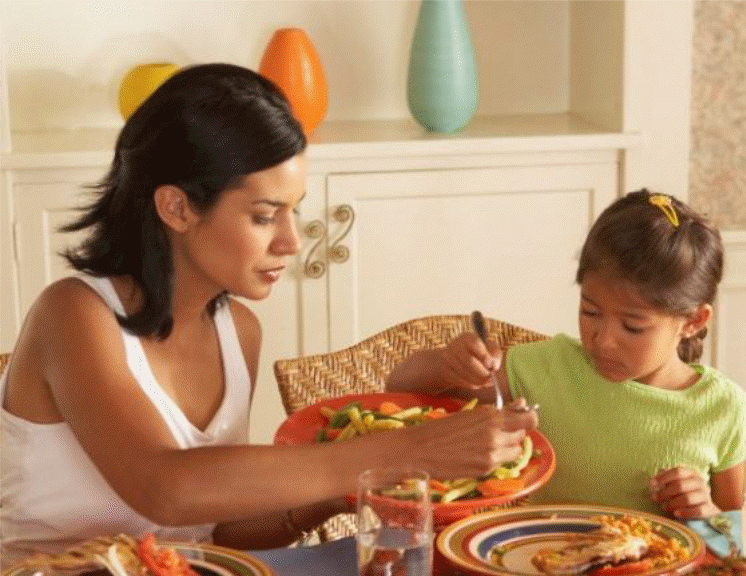
Let them learn by serving themselves.
Your
kids will learn many useful life lessons when you let them serve
themselves at meal time:
They learn to make decisions about which foods and how much to put on their plates.
They learn to be more aware of when they are hungry and when they are full.
They further develop their fine motor skills and hand-eye coordination.
They learn to share, take turns, and be responsible for their choices.
CF1b.
Try these tips to make serving themselves an even better experience.
Use small bowls so your kids can see the food, and use serving utensils they can hold easily in their little hands.
Hold the serving bowls for them to make it easier to scoop up the food.
Be patient! Your kids are learning, so be ready to wipe up a few spills.
Encourage and praise your children when they serve themselves.
CF2a.
Help your child learn to love a variety of foods.
Offer and encourage your kids to taste new foods. When they do, reward them with praise instead of treats.
CF2b.
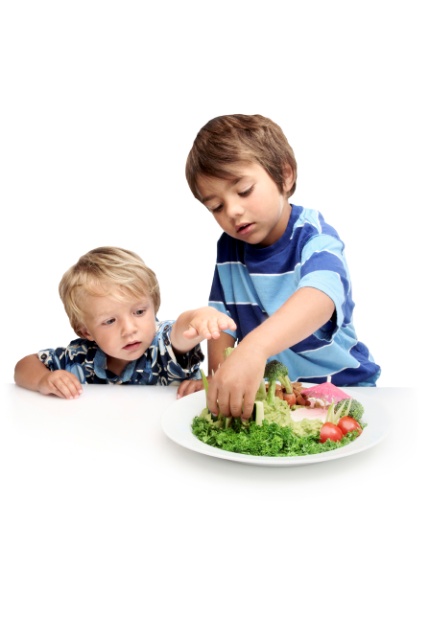
Kids learn to like new foods by:
Having them offered over and over
Having them served with familiar foods
Seeing friends, older kids, and grown-ups eating these foods
Tasting them prepared in different ways
Choosing foods to try themselves
Starting with small amounts
CF2c.

Offer a new food many times. Keep trying.
Try offering new foods prepared in different ways. You can serve fruits and vegetables raw with a dip. You can also steam, roast, and bake vegetables—even some fruits. For example, try warming fruits like apples, pears, and peaches for about a minute or so for a softer texture. Try it with canned, frozen, or fresh fruit – just look for canned or frozen fruits without added sugar or packed in 100% fruit juice.
Many young children need to be offered a new food several times before they will try it and learn to like it. So, offer a small amount. If you keep offering a new food, eventually your kids will give it a try.
CF3a.

Moms often ask:
Q. How do I know my kids are getting enough food and nutrition?
A. Young children eat when they are hungry and usually stop when they are full. It’s also helpful to know that before eating, their stomachs are about the size of their fist. So what may not look like much food to you may actually be just right for their small stomachs.
CF3b.
Q.
What can I do to help my children develop healthy eating habits?
A. It can take patience, but try some of these tips. They've worked for many moms.
Offer young kids the same healthy foods the rest of the family is having. Your child may not care for all that’s offered, and that’s okay. Kids eat better when they have the freedom to select what to eat from what you offer.
Try to set regular times for meals and snacks. A daily routine of regular meal times and snack times promotes good eating habits. It helps kids learn there is always another chance for them to eat what they need.
Lay out a variety of healthy foods and then let kids serve themselves. Children learn and gain confidence when they are allowed to make choices about what to eat. And remember, a serving size for young kids is smaller than for teens or an adult.
Listen to them when they say they are full. Young kids will eat the amount they need. Toddlers have a strong sense of hunger, appetite, and fullness, so they are likely to stop eating when they are full rather than when the food is gone. And, children's appetite can vary - sometimes they won't eat much and other times they will want seconds.
CF4.

Cook together. Eat together. Talk together. Make mealtime a family time.
Make meals and memories together. It’s a lesson they’ll use for life.
CF5.
Make meals and memories together. It’s a lesson they’ll use for life
CF4a.
It takes a little work to bring everyone together for meals. But it’s worth it and the whole family eats better.
Start eating meals together as a family when your kids are young. This way, it becomes a habit.
Plan when you will eat together as a family. Write it on your calendar.
You may not be able to eat together every day, but aim to have family meals at least four times a week.
CF4b.

How to make family meals happy
Focus on the meal and each other. Turn off the television. Take phone calls later.
Talk about fun and happy things. Try to make meals a stress-free time.
Encourage your child to try foods. But, don’t lecture or force your child to eat.
CF4c.

Fast family meals
Cook it fast on busy nights. Try stir-fried meat and vegetables, quick soups, or sandwiches.
Do some tasks the day before. Wash and cut vegetables or make a fruit salad. Cook lean ground beef or turkey for burritos or chili. Store everything in the fridge until ready to use.
Find quick and tasty recipes that don’t cost a lot to make at:http://www.fns.usda.gov/eatsmartplayhardhealthylifestyle/QuickandEasy/smartstartrecipes.htm
CF4d.
Talk to me!
What made you feel really happy today?
What did you have to eat at lunch today?
What’s your favorite veggie? Why?
Tell me one thing you learned today.
What made you laugh today?
CF5a.

Teach
your kids to create healthy meals. It’s a lesson they’ll
use for life.
Kids like to try foods they help make. It’s a great way to encourage your child to eat fruits and vegetables. They feel good about doing something “grown-up.” Give them small jobs to do. Praise their efforts. Their smiles will light up your kitchen.
Kids love helping in the kitchen. Parents love knowing that their child is also learning skills they’ll use for life. Help teach them to follow instructions, count, and more!
C F5b.
F5b.
Prepare fruits and veggies together.
Children learn about fruits and vegetables when they help make them. And all of that mixing, mashing, and measuring makes them want to taste what they are making. It’s a great trick for helping your “picky eater” try fruits and vegetables.
CF5c.
On
busy weeknights…
Cooking
together can mean more “mommy and me” time on busy days.
Ask your child to help with easy tasks, like adding veggie toppings to a cheese pizza.
Let your child choose which veggies to add to soup. Only an adult should heat and stir hot soup.
Make sandwiches together.
CF5d.
Make
some meals special.
Have a color contest and see how many green, red, yellow, and orange fruits and vegetables you can include in one meal.
Name a food your child helps create. Make a big deal of serving “Karla’s Salad” or “Corey’s Sweet Potatoes” for dinner.
Try a “Make Your Own” night. Let your family put together its own soft tacos, sandwiches, pizza, or salads.
Place the ingredients within easy reach and let the fun begin.
CF5e.
Cooking Together Activities by Age:
2-year-olds |
3-year-olds |
4- to 5-year-olds |
|
|
|
|
|
|
CF6.1
They learn from watching you. Eat fruits and veggies and your kids will too.
CF6.2

They learn from watching you. Eat fruits and veggies and your kids will too.
“My 3-year-old picks up on so much. She loves to copy what I do. Sometimes she will ask for a food she saw me eat. And I didn’t even know she was watching me! So, I try to eat fruits and vegetables. That way she’ll want them too. My doctor told me that kids learn eating habits when they are young. I want my child to learn to eat fruits and vegetables so she’ll be healthy. It makes me feel good that I’m teaching her something she’ll use for life.”
CF6a.

How can I help my child eat more fruits and vegetables?
Eat together. Let your child see you enjoying fruits and vegetables at meals and snacks.
Take it with you. Show your child how whole fruit is a great snack to eat at the park or in the shopping mall. Put apples, oranges, or bananas in your bag for quick snacks.
Share the adventure. Try new fruits and vegetables together.
Fix them together. Teach your child to tear lettuce or add veggie toppings to pizza.
CF6b.
Why does it matter what I do?
They learn by watching you. Kids get curious when they see you eating fruits or vegetables. Before you know it, they’ll want to taste what you are having.
You teach them lessons they’ll use for life. It’s normal for 2- to 5-year-olds to be “picky” eaters. Help them increase the types of fruits and vegetables they like by setting a good example.
CF6c.

What kinds should we eat?
Fresh, frozen, and canned fruits and vegetables are all smart choices. Buy some of each to last until your next shopping trip.
Frozen vegetables have as many vitamins and minerals as fresh. Choose packages that contain vegetables --and nothing else—no added fat, salt, or sugars.
Buy canned fruits that are packed in “100% juice” or water.--
Rinse canned beans and vegetables with cold water to make them lower in salt.--
Look for canned vegetables that say “No added salt” on the front of the can. Buy them when they go on sale.
Cooked vegetables or ripe fruits that are cut into small pieces are easy for your child to eat.
CF7.

Enjoy
each other while enjoying family meals.
Keep
meal time relaxed to nourish the body and help your family make
stronger connections. Let your little ones select which foods top on
their plates and how much toe at from the healthy choices you
provide.
CF8.

Feed
their independent spirit at meal times.
Each
meal with your preschoolers is a chance to help them grow and learn
to make some decisions on their own. Encourage them to make their own
food choices from the healthy foods you offer. Start early and you’ll
help them build healthy eating habits for life.
CF7a.

Lead the Way:
Creating a Relaxed Meal Time Experience
In our home, we have two rules when it comes to meal time: eat as a family whenever we can
and keep it relaxed. Since we started eating together more often, our family is getting closer
all the time. We talk, we laugh, and my little ones are choosing healthy foods. Plus, their
table manners are improving! Here’s what we do to make meals more relaxed around our
home:
a) Remove distractions. We turn off the
television and computer, and avoid talking on the phone or texting, so our attention is on each other.
b) Talk to each other. We focus our
conversation
on what we did during the day.
We talk about what made us laugh
or what we did
for fun. For example, we ask, “What was
the best part of your day today?”
c) Pass on traditions. I tell the kids about the “good old days,” foods mom and grandma made that we loved to eat.
d) Let kids make choices. We set a healthy table and let everyone, including the kids, make choices about what they want and how much to eat.
e) Let everyone help. Kids learn by doing. So, the little one might get the napkins and older kids help with fixing foods and clean‐up.
CF8a.

Feeding
Kids’ Independence at Meal Time
Young children are fast learners, so it’s a great time to help themdevelop healthy eating habits. Healthy eating means eating a variety of foods from all food groups. It also means eating fewer foods with added sugar, salt, and solid fat. With a little planning, you can give your child more opportunities to grow and learn to make healthy eating choices. Think of this as planning for everyone in your family. And remember, you don’t have to do everything at once. Try adding one new idea at a time, then build from there.
CF8b.

HELPFUL TIPS:
a) Set a regular schedule for meal times. Young children need routines to practice new skills, like trying healthy foods.
b) Keep healthy snacks available. Place them in a drawer or on a shelf that young kids can reach. When you say it’s OK, your kids can choose their own healthy snack.
c) Help your children feel more independent. Let them pick from healthy food choices you offer. For example, they can choose between an apple or orange and a whole‐wheat pita with salsa for a snack.
d) Make finger foods. Prepare foods that kids can eat with their fingers, such as vegetable or fruit chunks. Kids love to dip, so serve finger foods with a dip like yogurt or dressing. Bitesized pieces of foods (no larger than a ½ inch) are easier for small kids to handle and help to avoid choking.
e) Make healthy eating fun. Fun ideas get kids excited to try new fruits and vegetables. Make an open face sandwich by laying a slice of low‐fat cheese on whole‐wheat bread. Add sliced tomatoes for eyes and a strip of bell pepper for a smile.
f) Eat with your children. They are more likely to try new foods if they see you eating and enjoying them.
g) Take them shopping. Ask your kids to pick a new fruit or vegetable that they want to try for dinner.
h) Involve the kids. As your kids grow, let them help prepare, serve, and clean up after the meal. For example, kids can help by measuring, adding ingredients, stirring, washing veggies, etc. Kids learn by doing, and being involved helps them be more confident and develop motor skills.
CF9.
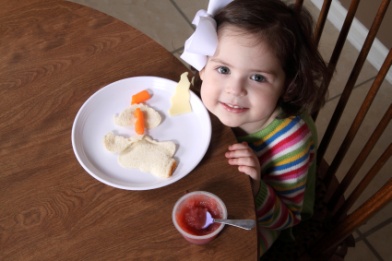
Let
go a little to gain a lot.
It’s
natural for moms to worry about their preschoolers’ eating
habits. Offer healthy foods and let your kids choose from them.
They’ll be more likely to enjoy meal time and eat enough, so
everyone is happier.
CF9a.

One Mom’s Story: The Big Pay Off
The other day, I overheard my 4‐year‐old daughter telling her friends, “At dinner, my mom lets me pick the foods I want and then I put them on my plate!” She was so proud of herself, and I was, too. I recently learned that letting kids choose from healthy food options helps them develop good eating habits and become more independent. I was having problems getting her to try different foods, so I decided to try letting her pick what to eat. Now she says, “Let me take a little of that squash, too, Mommy.” She also helps to plan and make dinner one night a week. She loves being Mommy’s helper and does a great job, too!
CF9b.
Q:
Why should I let my kids make decisions about which foods and how
much to eat?
A: Here are a few of the many reasons:
It
helps moms:
Make meal time more pleasant for everyone.
Eliminate ‘power struggles’ and arguments about eating.
It helps kids:
Gain confidence.
Become more independent as they adjust to preschool.
Sense when they are hungry and when they are full.
Learn to eat healthy now and for life.
CF9c.
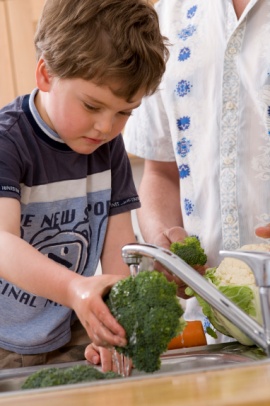
Q: How can I help my kids form healthy eating habits and learn new skills?
A: Try these tips:
Get them involved in preparing meals.
Set a positive example. Offer the same foods to everyone.
Set regular times for meals and snacks.
Let kids pick what to eat and serve themselves from the meals you provide.
Trust your kids to eat enough of the right foods over time.
Slow down, relax, and enjoy each other’s company at meal time.
CF10.

Think
beyond a single meal. Keep in mind what your child eats over time.
Meals and healthy snacks give children several chances every day to eat a variety of foods. If your child eats only a little or nothing at one meal, don’t worry. He’ll make up for it with other meals and snacks to get what he needs for good health over time.
CF10a.

Advice from a Nutritionist
As a nutritionist, I work with a lot of moms who are concerned about whether their child is getting enough of the right foods to grow and develop well. I tell them to look at what their child has eaten during the last couple of days, not just one meal. You see, kids’ appetites vary. For any given meal, a young child might eat very little or nothing at all. And that’s completely normal. It’s also normal for children to go through a period where they’ll only eat one food. Try to be patient and continue to offer healthy meals and snacks, that includes foods like low‐fat (1%) milk, yogurt, lean meats, fruits, veggies and whole‐grain foods. That’s how you can make sure that over time, your little ones are getting the nutrients they need.
Closing Question
Of all of the ideas we talked about this evening, which one would you be most likely to try in your own household or to tell a friend to try?
| File Type | application/vnd.openxmlformats-officedocument.wordprocessingml.document |
| File Title | CMOM Healthy Living Project Pre- Post Questionnaire |
| Author | Martha |
| File Modified | 0000-00-00 |
| File Created | 2021-01-30 |
© 2025 OMB.report | Privacy Policy


